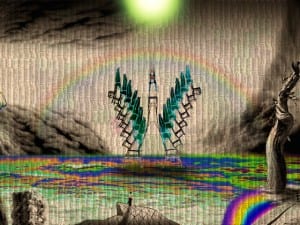The Jerwood Contemporary Painters Exhibition highlights 20 emerging artists in one vibrant collection. Each artist exhibits one work, which is concerned with the debate of what painting is, and what it may become. The exhibition offers an exciting opportunity for emerging artists who are at a particular stage in their development, those falling between student and recognised artist status.
Is painting dead? This question has been discussed and debated until critics, art historians, academicians, and artists are blue in the face. The Jerwood Contemporary Painters Exhibition is about what painting is, what it is to become; and one thing it is completely confident about is that painting is by no means dead.
The exhibition has, as its fundamental underpinning, a competition of sorts, though the curators / judges (Stephen Farthing, Anita Taylor and Jason Brooks) are quick to point out that this isn’t necessarily a prize. Farthing, a Royal Academician and Professor of Fine Arts says, “In theory the show is a 2007/08 audit of what’s been going on in painting since these artists graduated in 2000.” The paintings exhibited are therefore not chosen for how they stylistically or thematically fit into a specific curatorial framework, but rather how they exist as separate entities. The show is about the painting itself; how these works represent the future of painting and, as Jason Brooks, an artist himself, says, “is more about what came together; the idea was to get debate going and to look at the relationship between these works and what came before them.”
The “prize” (or exhibition), which began in 2006 under the aegis of the Jerwood Foundation, has been democratic since inception: there is no one winner, but twenty selected artists who each receive £1,500, and have their work exhibited in a group show, which itself is not based on any specific hierarchical framework. Unlike art competitions, such as the Turner Prize, which naturally breed a competitive atmosphere through the fact that ultimately there will be only one winner, the Jerwood Foundation’s Visual Art Series deals with supporting artists and their careers, and thereby creates an environment of unity. The twenty artists selected do not necessarily have instant name recognition; the Foundation seeks to support artists that are not yet at that stage in their work and to sustain this burgeoning field of young artists rather than maintain and recapitulate the achievements of established artists.
Artists are inherently competitive; it is, as Brooks succinctly reiterates, “the nature of the beast”, so it is refreshing to see a selection of works exhibited without the dogma of “winners and losers”. The works are hung in a way that makes sense to the curators and that creates a more interesting debate and narrative. Farthing states that at the beginning they had no idea how the exhibition would turn out: “The paintings are fragments that might fit together; we didn’t know whether they would work together as a whole when we chose them. We chose them for quality, craftsmanship and that “voodoo” factor; that enigmatic, indefinable quality of a great painting”. This “voodoo” factor is in some ways the essence of painting, and thereby the reason why neither Farthing nor Brooks choose to predict or discuss what might be the future of painting; because it is virtually impossible to predict the unknown.
The selection process, as one would imagine, was an arduous and often difficult task. Brooks, Farthing and Taylor each selected a roster of about twenty artists to form a pool of roughly sixty, from which they culled twenty artists whom they all felt deserved to be featured in the exhibition. Jason elaborates that the reason he chose many of the works is for their discursive quality, “for the paintings ability to transcend time really. It needs to have substance but the work also needs to be able to survive in a different context other than artists’ studio wall.”
The idea that there might be a London-centric quality to the exhibition is unavoidable; there is inevitably a gravitational pull to London for artists, just as there is to New York or Paris. These are all major metropolises, with a strong cultural scene and artistic market; geographical locations that have become more and more attractive to young, ambitious auteurs and artists. The Jerwood Foundation and the selection committee (Brooks, Farthing & Taylor) recognise this and were therefore insistent on using as many contacts, personal or otherwise, to bring together the ultimate twenty artists.
The works that were chosen are by artists, not necessarily from London, but from throughout the United Kingdom and even abroad. Farthing states that it would have been virtually impossible to see the wide and varied selection that they did without the Internet, but that even so he, Brooks, and Taylor always insisted on seeing the physical work (rather than as a form of digital media): “We aren’t a SWAT team. We couldn’t be everywhere at once and that’s when the i nternet helped. We often had digital images sent to us; this helped us cover more ground quickly and without a lot of expenses. The problem of course, is that there are a lot of great images out there but that doesn’t necessarily mean a lot of great paintings; the images need to work in real-life”. Farthing and Brooks both seem satisfied that they, along with Taylor, have fulfilled their task; that the exhibition provides a brief overview of the developments and evolutions occurring within the field of painting. That all three managed to agree on twenty individual artists and walked away from the experience unscathed is indicative of the fact that they may have been much more successful in this task than they themselves are even aware.
The Jerwood Contemporary Painters Exhibition ran from 9 April until 18 May 2008 at the Jerwood Space (171 Union Street, London). www.jerwoodvisualarts.org.
Niamh Coghlan





